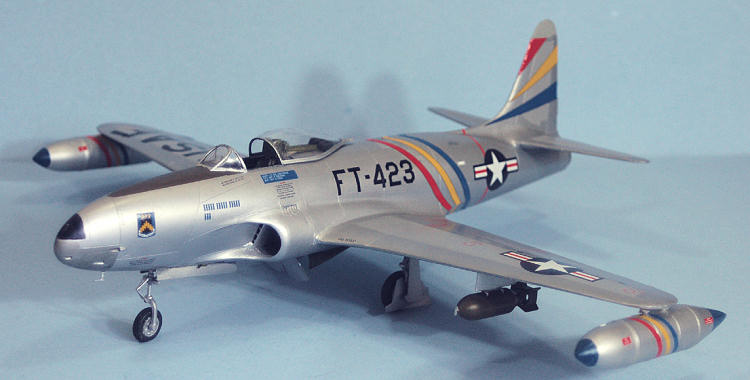
| KIT #: | 3202 |
| PRICE: | $79.95 MSRP |
| DECALS: | Three options |
| REVIEWER: | Tom Cleaver |
| NOTES: |
|

| HISTORY |
The prototype, now known as the XP-80 and nicknamed “Lulu-Belle”, was
completed in 141 days, just in time to be mated to the British Goblin turbojet -
which had been taken directly from the first Vampire prototype and shipped to
the United States. On
With the knowledge that the German Me-262 was close to entering
production, development was accelerated on the P-80, now known as the “Shooting
Star.” In February 1944, a contract
was let for production of 13 XP-80A aircraft, which would have a longer fuselage
and a different engine, the General Electric I-40, later known as the J-33.
A production order for 500 P-80As followed in March 1944. The XP-80As
began delivery in September 1944, and in February 1945, three YP-80A aircraft
went to
Following the end of the war, the Air Force moved to bring the P-80A into
service, with the 412rg Fighter Group, which had been the only unit equipped
with the P-59A, receiving their P-80s in November 1945.
Over the next four years, the P-80 - known after October 1948 with the
creation of the
The Shooting Star fighter model was the P-80C, with production
encompassing 162 P-80C-1‑LO, 75 5‑LO and 561 10‑LO production blocks.
Redesignated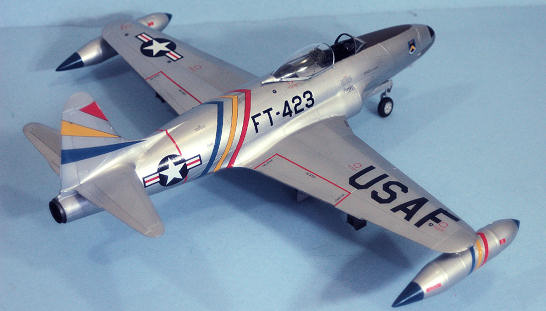 as the F‑80C, 128 original F-80As were brought up to the F‑80C‑11‑LO standard.
The F-80C was powered by the J33‑A‑35 engine and received an early
ejection seat (actually a catapult seat) as factory-installed equipment, and was
also the first USAF fighter to feature an effective explosive canopy jettison
process. Following the outbreak of
war in
as the F‑80C, 128 original F-80As were brought up to the F‑80C‑11‑LO standard.
The F-80C was powered by the J33‑A‑35 engine and received an early
ejection seat (actually a catapult seat) as factory-installed equipment, and was
also the first USAF fighter to feature an effective explosive canopy jettison
process. Following the outbreak of
war in
When war came in Korea with the invasion by North Korea on June 25, 1950,
the American forces in Japan were far from ready for combat.
The 51st Fighter Group had been operating the F-80 since the
end of 1948, while the 8th Fighter Group had only recently converted
to the airplane from P-51 Mustangs. Fortunately, with a major officer
reduction‑in‑force having been completed over the previous six months, most
pilots were experienced, stable, and seriously aggressive.
At the outbreak of war, a substantial number of F-80s could not carry
either wing-tip tanks or bombs.
There were no forward airfields in Korea that could handle jet aircraft,
which meant the F-80s had to fly from Itazuki AFB on Kyushu, and had an
effective loiter time of only 20 minutes over the 38th Parallel, the
point of invasion. The Misawa tanks that were quickly produced by adding an
extra section to the existing tank, were heavy enough that some aircraft
eventually suffered wing failure.
US Forces were authorized to entire combat by President Truman on June
26, 1950.
The 8th
Fighter-Bomber Group:
Based at Suwon from the summer of 1951, the 8th Fighter‑Bomber Wing,
composed of the 35th, 36th, and 80th
Fighter‑Bomber Squadrons, was the longest‑serving F‑80 unit in Korea and
continued to fly the Shooting Star until May 1953, when it converted to F‑86
Sabres.
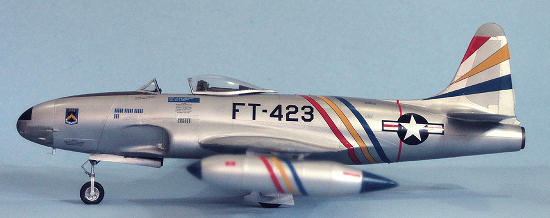 The Shooting Star first saw air combat on June 27, 1950, when the 8th
Fighter Bomber Wing launched four F-80s of the 35th FBS, flown by 1st
Lt Robert Dewald, 1st Lt. Ralph Hall, 1st Lt Wayne and led
by CAPT Ray Schillereff, to patrol Kimpo Airfield at Seoul while General
MacArthur flew into Kimpo for a first-hand look at the situation.
The Shooting Star first saw air combat on June 27, 1950, when the 8th
Fighter Bomber Wing launched four F-80s of the 35th FBS, flown by 1st
Lt Robert Dewald, 1st Lt. Ralph Hall, 1st Lt Wayne and led
by CAPT Ray Schillereff, to patrol Kimpo Airfield at Seoul while General
MacArthur flew into Kimpo for a first-hand look at the situation.
The first American aerial victory of the war happened over Kimpo, and
went to 1st Lt Hudson, flying an F-82G of the 68th
All-Weather Fighter Wing; the F-82s were patrolling Kimpo to protect the
evacuation of American personnel by C-54s, when North Korean aircraft made a
low-level strafing attack. Hudson
shot down what was believed to have been an Il-10 Shturmovik, but might have
been an La-9 or a Yak-9U. An hour
later, the four F-80s from the 35th FBS were in action against North
Korean Il-10 aircraft that swept in over Kimpo at low level.
While there is no dispute that the 35th FBS got the USAF’s first jet
kill, there is dispute over who actually got that first jet kill.
According to “Crimson Sky: The Air Battle for Korea,” 1st
Lt Robert Wayne, covered by his wingman 1st Lt Ralph Hall,
shot down the first two Il‑10s, with CAPT Ray Schillereff and 1st Lt
Robert Dewald picking off one each
of the fleeing bombers. Other
sources say that Schillereff and Dewald were the first victors, which
demonstrates just how fast the fight happened.
The first fighter‑bomber missions were launched on June 28, 1950.
These were mainly armed reconnaissance missions aimed at blasting moving
columns of enemy equipment, supplies, and personnel.
They were not particularly effective at first, due to the fact the 8th
Fighter Bomber Wing had not gotten into gear before the war, and the pilots did
not have the training in ground attack to operate effectively.
Thus, the unit’s pilots taught themselves through often-deadly experience
how to do their job. Over the next two and a half years, of the 277 F‑80s lost
in operations - approximately 30% of the existing inventory - 113 were destroyed
by ground fire and 14 were shot down by enemy aircraft
As is pointed out in “Crimson Sky,” “...F‑80 pilots felt they were doing
the dangerous interdiction work but receiving no credit... As a result,
fighter‑bomber units took greater pride in unit accomplishments versus the
individual pilot accomplishments. Squadrons had special baseball caps and beer
steins made. Each squadron custom‑designed and ordered its own cap from Japanese
manufacturers. The squadron logos in Korea were emblazoned on caps, signs, beer
mugs, jackets, and flight suits.”
The operation life of a fighter‑bomber pilot was hazardous and often
short. 147 Air Force aircraft were lost in air‑to‑air combat; by comparison,
over 816 aircraft were shot down by ground fire. As Raymond Sturgeon, a pilot
with the 35th FBS, put it, "I had friends in F-86s who never saw a
MiG their entire tour, but we got fired on every mission with high‑powered guns
that shot golf balls at you." The 35th FBS
lost "a pilot or two" every week, and losses like these were not unusual
in the Wing.
The F-80 had more than a few bugs.
It needed an elaborate water injection system just to take off from many
of the rather short runways in Japan and Korea. Water injection worked like a
primitive after‑burner: water was injected into the combustible mixture , giving
it three or four hundred more pounds of thrust.
However, this system could frequently fail.
Additionally, when fully loaded with drop tanks and up to 2,000 lbs of
bombs, the F‑80 could not get airborne without JATO, and these units were also
prone to failure. As one pilot
remembered, every combat takeoff was an adventure.
Additionally, the wing tanks also had a propensity not to feed well.
On top of all this, the airplane had never been designed for the ground
attack role, and had no additional armor protection for the pilot or any
critical system, making the F-80 very vulnerable to massed ground fire from
large and small-caliber automatic weapons, which the pilots faced on every
bombing sortie.
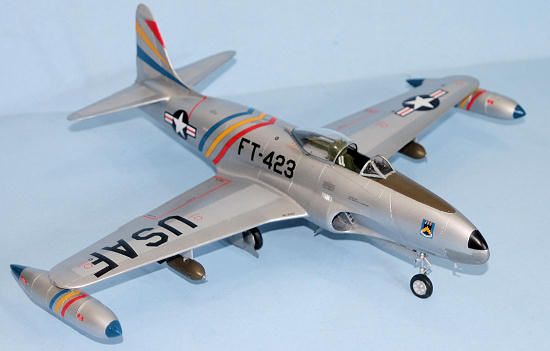 LCOL
Levi R. Chase, 8th FBW Commander:
LCOL
Levi R. Chase, 8th FBW Commander:
I found it surprising to discover that the pilot whose airplane is
Markings Option Number 3 in this kit was a man I had never heard of before.
It turns out, Levi R. Chase was the top-scoring American fighter pilot
during the North African campaign with 10 victories, and the only American
fighter pilot to score against all three Axis air forces (9 German, 1 Italian, 2
Japanese). He served with the 2nd
Air Commando in the
Levi R. Chase was born in Cortland, N.Y., on December 23, 1917. Quitting
college during his junior year at Syracuse University in November 1940 because
he could see war was coming, Chase joined the Air Corps and was accepted as an
aviation cadet. As a member of Class 41‑G, he received his pilot wings and
commission as a Second Lieutenant in September 1941 at Maxwell Field, Alabama,
and was assigned to the newly-formed 58th Pursuit Squadron of the 33rd
Pursuit Group.
Chase first saw combat with the 33rd Fighter Group in November
1942, when they flew their P-40Fs off the USS Ranger to join Operation
Torch. By that December, he’d been
promoted to Captain and scored two victories - a Bf-109 and a Ju-88.
At the time of the German surrender in Tunisia in May, 1943, Chase was a
Major, Squadron C.O. of the 60th Fighter Squadron, and the leading
American ace of the campaign with ten victories - eight Bf-109s, one Ju-88, and
one Macchi C.202. In addition to
aerial fighting, he’d become a leading exponent of close air support for the
ground forces when the 33rd worked with the French armored unit and
the British Eighth Army during the fighting after Kasserine Pass. Like many of
the leading P-40 pilots, he believed the airplane was better than the tales told
about it, so long as one kept their speed up and stayed in the vertical plane,
not playing the enemy’s game in combat.
The 33rd Fighter Group was led for a time by the legendary
Phil Cochran, who later was the prototype hero for the "Terry and the Pirates"
comic strip. Cochran dubbed Chase his "One‑Man Wave of Terror" for his
aggressive and relentless pursuit and attack of enemy targets in the air and on
the ground. The Free French awarded
him the Croix de Guerre for his work in support of General LeClerc’s armored
unit during the assault on the Mareth Line, while the British awarded him the
Distinguished Flying Cross twice for close support operations in support of the
Eighth Army.
Following the Tunisian campaign, Levi Chase returned to the United
States, where he made war bond tours and then worked in the training command
with his old C.O. Phil Cochran and new friend Major Johnny Alison, formerly of
the 23rd Fighter Group.
When Cochran and Alison formed the 2nd Air Commando Group, he went
along as the fighter commander.
Chase was a very effective leader of the First Provisional Fighter Group
during his second combat tour in the China-Burma-India Theater.
Flying from Cox's Bazaar in India,
he led the two squadrons of the 2nd Air Commando in a mission to strike
Don Muang Airfield in Bangkok on March 15, 1945, a mission that covered over
1,500 miles round trip, and was the longest P-51 mission ever flown.
For this, he was awarded the Silver Star, while the 1st
Provisional Fighter Group received a Distinguished Unit Citation.
Earlier, during the Chindit operation in Burma, Chase was shot down
behind enemy lines and crash-landed.
Two of his pilots landed at Broadway airfield and took two L-5s to go
find him. One landed and picked him
up, while a Japanese patrol was just over the hill from them.
During this second combat tour he shot down two Oscars, thus becoming the
only American fighter pilot to score against all three Axis air forces.
After the war, Levi Chase returned to civilian life, to his wife and
eldest son. He returned to college,
finished his degree and then gained a law degree from Syracuse University in
1949.
 The Korean War brought his recall to active duty, which was something he
did not complain about. He served successively as the Deputy Group Commander of
the 1st Fighter Group, flying the F-86A Sabre; Executive Officer of
the 56th Fighter Interceptor Wing and then Commander of the 63rd
Fighter Interceptor Squadron. In November 1951, he went to Korea, where he
served as Deputy Commander, Operations, in the 51st Fighter Interceptor Wing, as
they transitioned to the F-86. In
April 1952, he became Group Commander of the 8th Fighter Bomber Wing.
During his time in command, he made a point as Wing Commander to lead the
“tough missions”, including the strikes against Pyongyang in the summer of 1952,
for which he received his second Silver Star.
The Korean War brought his recall to active duty, which was something he
did not complain about. He served successively as the Deputy Group Commander of
the 1st Fighter Group, flying the F-86A Sabre; Executive Officer of
the 56th Fighter Interceptor Wing and then Commander of the 63rd
Fighter Interceptor Squadron. In November 1951, he went to Korea, where he
served as Deputy Commander, Operations, in the 51st Fighter Interceptor Wing, as
they transitioned to the F-86. In
April 1952, he became Group Commander of the 8th Fighter Bomber Wing.
During his time in command, he made a point as Wing Commander to lead the
“tough missions”, including the strikes against Pyongyang in the summer of 1952,
for which he received his second Silver Star.
In December 1952, he returned to the United States to become Commander of
the 3600th Combat Crew Fighter Training Wing at Luke AFB in Arizona, where he
founded the USAF Flight Demonstration Team known as The Thunderbirds.
In 1963, Colonel Levi Chase was assigned as commander of the 12th
Tactical Fighter Wing, the first USAF unit to operate the F-4C Phantom.
He took the unit to Vietnam in 1965, flying out of Cam Ranh Bay in
strikes through both North and South Vietnam, during which service he received
his third Silver Star for bravery and combat leadership.
Promoted to Brigadier General in 1969, Chase was promoted to Major
General in 1972 and retired from the Air Force in 1973 as Commander of Ninth Air
force. His last flight as Pilot in
Command was at Shaw AFB in 1973, flying an F-4E Phantom.
At that time, he had logged over 5,700 hours in jet fighter aircraft.
He died in 1996.
Chase’s son, Tom, writes of his father thus: “Levi Chase took his roles as an Air Force officer, commander and fighter pilot quite seriously and did not seek publicity. He did not want to see the serious business of war and military service glamorized or trivialized. In short, he did not seek the limelight. Unfortunately, this means that despite his combat record and accomplishments, he was not as well‑known to the public as many other fighter pilots who may have been covered a bit more by the press.”
| THE KIT |
The very first model airplane I ever made was a P-80, a solid wood model
from Strombecker that my dad bought for me and told me I was ready to build it.
It wasn’t up to the standards he had produced making Strombecker models
for me, but I was on my way. The
second plastic model airplane kit I ever built was the Lindberg F-80C - which is
still being released by that company, 57 years on.
I built the Airfix F-80 when it came out and was disappointed, then
Monogram released their F-80C. I suppose over the 30 years since I have built
ten or fifteen of these; it’s not an easy kit, the fit is atrocious, but the
result can be nice and over the years MicroScale released enough aftermarket
decals for the kit to make it fun.
I’m sure the model will be re-released in the future by Revell, though the
decals are now sadly only available on eBay.
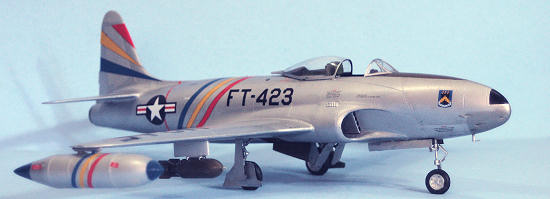 This 1/32 kit is the first in this scale I am aware of, past an ID Models
vacuform from the 1980s that fully justifies the fears most modelers have about
vacuforms. Scott Van Aken covered what’s in the box very well with his preview.
This 1/32 kit is the first in this scale I am aware of, past an ID Models
vacuform from the 1980s that fully justifies the fears most modelers have about
vacuforms. Scott Van Aken covered what’s in the box very well with his preview.
The kit cockpit and seat are wrong for an F-80C, with the seat being more
for the T-33; since this is a coming attraction in this series from Czech Model,
which is produced by MPM, that’s not surprising.
Fortunately, Harold Offield of
The kit “Misawa tanks” are not exactly right in shape, and True Details has made a set of tanks that does have the correct bluntish shape to the nose. These are solid resin and heavy, and unfortunately True Details made some very delicate, fragile, and virtually useless connection points to the underwing pylons, which only make more problems. After using them, I would say that the kit tanks are good enough, and being injected plastic you will not be creating problems down the road; these tanks are heavy enough that in a few years the wings may bend under the weight. I do not recommend these, and if I had not wrecked the kit tanks trying to fix the problems with these tanks, they would have ended in the round file, unmentioned further.
| CONSTRUCTION |
Again, Scott’s
review certainly caught all the problems.
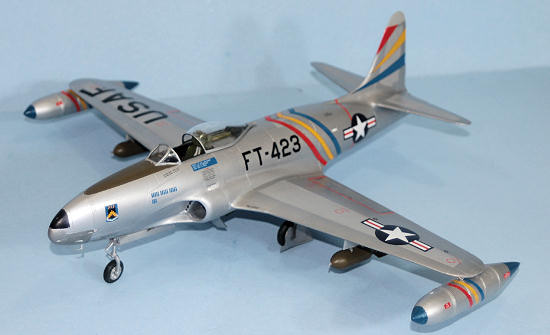 The main problem in construction is that the inner face of the intake
trunking was made as one piece, to be attached to the lower wing and then slid
into the fuselage subassembly later.
This is truly idiotic, and is the kind of ill-fitting design choice one
could only expect from an MPM designed kit.
The simple solution is to cut the part in half and attach them to the
intake trunking while you are assembling that with the fuselage halves still
open. If you do that, all the fit
problems others have cried about will be solved.
The main problem in construction is that the inner face of the intake
trunking was made as one piece, to be attached to the lower wing and then slid
into the fuselage subassembly later.
This is truly idiotic, and is the kind of ill-fitting design choice one
could only expect from an MPM designed kit.
The simple solution is to cut the part in half and attach them to the
intake trunking while you are assembling that with the fuselage halves still
open. If you do that, all the fit
problems others have cried about will be solved.
Past that, just remember it’s really an MPM molding, which means it’s
still a limited run kit that will require you to test fit, perform minor
surgery, test fit again, glue, fill the seams, sand down, fill the seams again,
etc., etc. I think of MPM kits as
being the plastic embodiment of the Mexican bandit in “The Treasure of the
Sierra Madre.” “Fit?
Fit?? We don’t need no
steenking fit!!! Damn gringo!”
Several “WTF” moments during the construction process - all of which are
answered by “It’s MPM!” - come to mind: the poor attachment of the nose gear
doors (did they ever hear of including the hinges?), the overall poor attachment
of the main gear doors (same question), and the completely idiotic way of doing
the tip tanks (they’d be poor even if you don’t use those resin boulders out
there).
Another thing: those itsy-bitsy resin pieces that are supposed to be the
machine gun muzzles are entirely likely to end up on the floor, where carpet or
not, they will be lost. Assuming
you don’t lose them, be sure to attach them before you paint the model, so you
don’t wreck the paint job attempting this.
This is another case of over-engineering to satisfy the “serious
modelers” (most of who don’t know what they’re on about), that would be far
better solved by having the muzzles molded in and asking the modeler to use a
bit of skill with a 0000 paintbrush.
With the resin cockpit, the main thing to do is to grind away the area in
the forward cockpit floor that will allow the nosewheel well to fit inside the
model. B e prepared for lots of
test-fitting and grinding. It’s
moments like this where I am glad I have a plug-in Dremel, since I’d have
exhausted the battery twice accomplishing this.
Fortunately, the cockpit fits perfectly.
Be 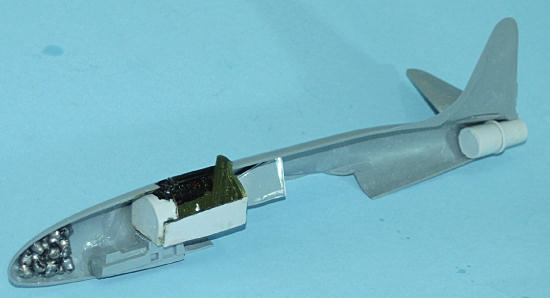 sure
to insert the seat before you close up the fuselage, because the seat is just a
bit wide for the cockpit opening with the resin walls.
If you’re dumb like me, you can squeeze it in, but you’re risking
breakage of a beautiful piece of resin casting, so put it in when it’s easy.
sure
to insert the seat before you close up the fuselage, because the seat is just a
bit wide for the cockpit opening with the resin walls.
If you’re dumb like me, you can squeeze it in, but you’re risking
breakage of a beautiful piece of resin casting, so put it in when it’s easy.
Harold’s set also includes a proper jet pipe that actually juts out of
the fuselage as it should. Be sure
once you have all this installed to fill that nose with lead weight before
closing it up to insure nose-sitting.
Be prepared for some industrial-strength pushing and shoving to get
everything into alignment when you assemble.
Once it’s all together you will need to fill all seams with cyanoacrylate
glue, then sand them down and cover with Tamiya “Mr. Surfacer,” sand them down
again, recover with glue and Mr. Surfacer, sand down again until smooth.
Once you have the seams filled, use different grits of sanding sticks and
polishing pads to get things nice and smooth with a polished surface because you
are going to apply a NMF surface.
When all this is done, rescribe all the panel lines you have sanded away.
| COLORS & MARKINGS |
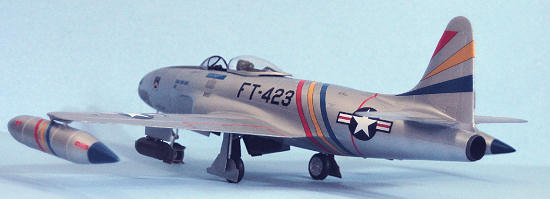 n
bay doors. I finished that by
tinting the Talon with a little bit of Tamiya “Gunmetal” and doing the panels of
the lower nose around the guns.
When all that was dry, I masked off the central areas of the wing, horizontal
stabilizer and vertical fin, and applied a very thin coat of Talon Aluminum
tinted with some light grey. It’s
so nice to be able to do a NMF finish on a model with this great paint; the
smell won’t have SWMBO coming after you with an ax, and it’s guaranteed not to
eat your model (like a certain non-acrylic metal finish is known to do if
applied too thick).
n
bay doors. I finished that by
tinting the Talon with a little bit of Tamiya “Gunmetal” and doing the panels of
the lower nose around the guns.
When all that was dry, I masked off the central areas of the wing, horizontal
stabilizer and vertical fin, and applied a very thin coat of Talon Aluminum
tinted with some light grey. It’s
so nice to be able to do a NMF finish on a model with this great paint; the
smell won’t have SWMBO coming after you with an ax, and it’s guaranteed not to
eat your model (like a certain non-acrylic metal finish is known to do if
applied too thick).
Decals:
The kit decals are very nice and go on without problem. If you decide to do this markings option, beware that the profile for the markings does not show the fuselage stripes as you can do them. Forget that and apply those stripes (they are each applied separately) so that they fit the airframe. The end result looks like a photograph of this airplane in the Squadron Walkaround book, so the markings instructions should be taken as suggestive only.
| FINAL CONSTRUCTION |
I did not like the 250-lb bombs supplied, and the pylon wasn’t so good, and then there were no sway bars. I sourced some 1,000-lb bombs, some Aero racks, and a set of swaybars that looked like what I saw in photos out of the spares boxes. I used the resin wheels, with the diamond-tread main wheels for no particular reason than they looked better with some “mud” weathering. I unmasked the canopy and windshield, and attached the canopy in the open position.
| CONCLUSIONS |
Not a kit for the faint-hearted.
There were several moments where I w as ready to chuck it, but continuing
on did result in something nice.
Squadron is notorious for having MPM do these things “to a budget” and that
means that not one of the kits in this series has ever been a “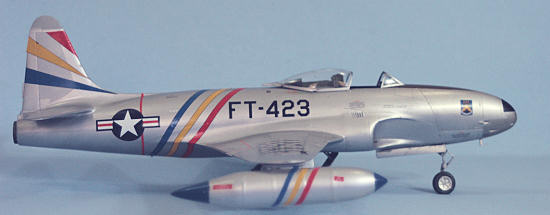 slammer.”
You need to know what is what technically for the airplane, you need to
have information on the specific one you are doing, and you must have a
willingness to use a liberal application of “some modeling skill required” and a
lot of elbow grease, not to mention industrial-strength pushing and shoving.
The Tamiya Spitfire IX this is not.
That said, if you want a good model of this important airplane in your
collection, I think this is the best kit of the F-80C in any scale, if final
result is your criteria. And you
will have a very nice feeling of having accomplished something when you look at
it on the shelf. Mine sits next to
my Fisher F9F Panthers and Kinetic F-86F Sabre on the “Korean War” shelf and
looks very good there.
slammer.”
You need to know what is what technically for the airplane, you need to
have information on the specific one you are doing, and you must have a
willingness to use a liberal application of “some modeling skill required” and a
lot of elbow grease, not to mention industrial-strength pushing and shoving.
The Tamiya Spitfire IX this is not.
That said, if you want a good model of this important airplane in your
collection, I think this is the best kit of the F-80C in any scale, if final
result is your criteria. And you
will have a very nice feeling of having accomplished something when you look at
it on the shelf. Mine sits next to
my Fisher F9F Panthers and Kinetic F-86F Sabre on the “Korean War” shelf and
looks very good there.
December 2009 If you would like your product reviewed fairly and quickly, please
contact
me or see other details in the
Note to
Contributors.